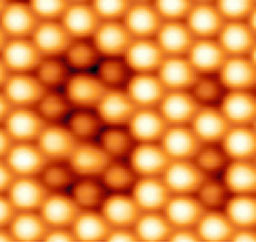 By Evan Ackerman
By Evan Ackerman
This “Si” is the smallest “Si” ever. The dots in this image are individual silicon atoms, and an atomic force microscope has stuck them one by one (over a period of an hour and a half these two letters) onto a surface of tin atoms. The letters measure about 2 nanometers across, meaning that you’d have to write “Si” over 125,000 times just to make it around one human hair.
As a researcher involved in the project says, “it’s not possible to write any smaller than this.” Not just impossible right now, but impossible ever, since atoms are the absolute smallest things stable enough to let us push them around. Yep, this is it, folks. You’re looking at it. End of the line, smallest “Si” ever, in the entire universe, until the end of time. Mission accomplished.
VIA [ Pink Tentacle ]





It could've been a lot worse. Thank God they didnt write “F1RST”
“it’s not possible to write any smaller than this.”
That is an incredibly naive statement. Firstly, “atoms are the absolute smallest things stable enough to let us push them around” that we know of right now.
Secondly, these are silicon atoms. If you use carbon atoms (one less electron shell) wouldn't it be smaller? Or helium (two less electron shells)?
Bah!
Heh, I was waiting for someone to bring that up :p
It's a little bit tongue-in-cheek for them to say (and me to repeat), I agree… But when you get much smaller than atoms, you're starting to get into particle-wave duality and stuff, where things don't really HAVE positions. But maybe the LHC will spit out something new to right with, who knows?
As to the atom sizes, yes, He has a smaller diameter than Si. But, you can't write on a He surface. It's also specific to the atomic force microscope that it spits out Si atoms. So maybe we'll invent a new microscope that uses a smaller diameter atom.
Personally, I dislike the idea that we've reached some kind of limit, here. I prefer to think that we have no idea what we'll be capable of in the future 🙂
Heh, I was waiting for someone to bring that up :p
It's a little bit tongue-in-cheek for them to say (and me to repeat), I agree… But when you get much smaller than atoms, you're starting to get into particle-wave duality and stuff, where things don't really HAVE positions. But maybe the LHC will spit out something new to right with, who knows?
As to the atom sizes, yes, He has a smaller diameter than Si. But, you can't write on a He surface. It's also specific to the atomic force microscope that it spits out Si atoms. So maybe we'll invent a new microscope that uses a smaller diameter atom.
Personally, I dislike the idea that we've reached some kind of limit, here. I prefer to think that we have no idea what we'll be capable of in the future 🙂
It could've been a lot worse. Thank God they didnt write “F1RST”
“it’s not possible to write any smaller than this.”
That is an incredibly naive statement. Firstly, “atoms are the absolute smallest things stable enough to let us push them around” that we know of right now.
Secondly, these are silicon atoms. If you use carbon atoms (one less electron shell) wouldn't it be smaller? Or helium (two less electron shells)?
Bah!
Heh, I was waiting for someone to bring that up :p
It's a little bit tongue-in-cheek for them to say (and me to repeat), I agree… But when you get much smaller than atoms, you're starting to get into particle-wave duality and stuff, where things don't really HAVE positions. But maybe the LHC will spit out something new to right with, who knows?
As to the atom sizes, yes, He has a smaller diameter than Si. But, you can't write on a He surface. It's also specific to the atomic force microscope that it spits out Si atoms. So maybe we'll invent a new microscope that uses a smaller diameter atom.
Personally, I dislike the idea that we've reached some kind of limit, here. I prefer to think that we have no idea what we'll be capable of in the future 🙂